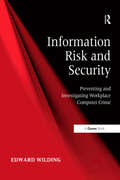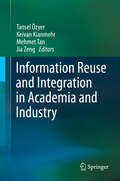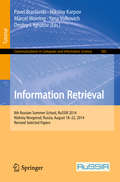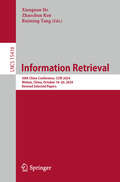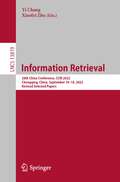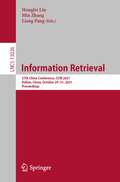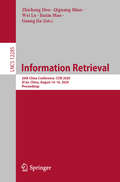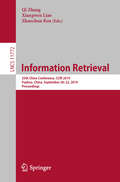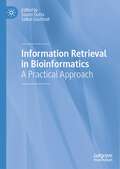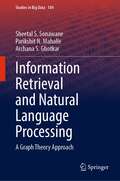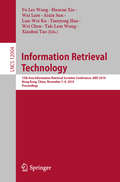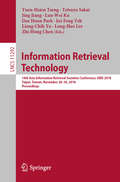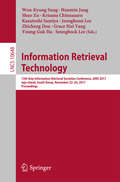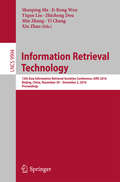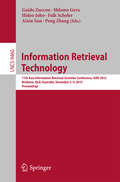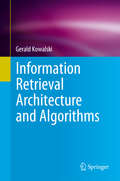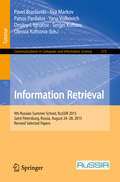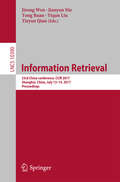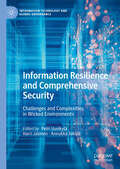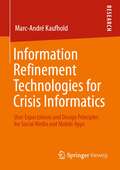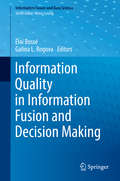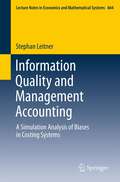- Table View
- List View
Information Risk and Security: Preventing and Investigating Workplace Computer Crime
by Edward WildingInformation Risk and Security explains the complex and diverse sources of risk for any organization and provides clear guidance and strategies to address these threats before they happen, and to investigate them, if and when they do. Edward Wilding focuses particularly on internal IT risk, workplace crime, and the preservation of evidence, because it is these areas that are generally so mismanaged. There is advice on: ¢ preventing computer fraud, IP theft and systems sabotage ¢ adopting control and security measures that do not hinder business operations but which effectively block criminal access and misuse ¢ securing information - in both electronic and hard copy form ¢ understanding and countering the techniques by which employees are subverted or entrapped into giving access to systems and processes ¢ dealing with catastrophic risk ¢ best-practice for monitoring and securing office and wireless networks ¢ responding to attempted extortion and malicious information leaks ¢ conducting covert operations and forensic investigations ¢ securing evidence where computer misuse occurs and presenting this evidence in court and much more. The author's clear and informative style mixes numerous case studies with practical, down-to-earth and easily implemented advice to help everyone with responsibility for this threat to manage it effectively. This is an essential guide for risk and security managers, computer auditors, investigators, IT managers, line managers and non-technical experts; all those who need to understand the threat to workplace computers and information systems.
Information Reuse and Integration in Academia and Industry
by Tansel Özyer Jia Zeng Keivan Kianmehr Mehmet TanThe present work covers the latest developments and discoveries related to information reuse and integration in academia and industrial settings. The need for dealing with the large volumes of data being produced and stored in the last decades and the numerous systems developed to deal with these is increasingly necessary. Not all these developments could have been achieved without the investing large amounts of resources. Over time, new data sources evolve and data integration continues to be an essential and vital requirement. Furthermore, systems and products need to be revised to adapt new technologies and needs. Instead of building these from scratch, researchers in the academia and industry have realized the benefits of reusing existing components that have been well tested. While this trend avoids reinventing the wheel, it comes at the cost of finding the optimum set of existing components to be utilized and how they should be integrated together and with the new non-existing components which are to be developed. These nontrivial tasks have led to challenging research problems in the academia and industry. These issues are addressed in this book, which is intended to be a unique resource for researchers, developers and practitioners.
Information Retrieval: 8th Russian Summer School, RuSSIR 2014, Nizhniy Novgorod, Russia, August 18-22, 2014, Revised Selected Papers (Communications in Computer and Information Science #505)
by Pavel Braslavski Yana Volkovich Dmitry I. Ignatov Nikolay Karpov Marcel WorringThis book constitutes the thoroughly refereed proceedings of the 8th Russian Summer School on Information Retrieval, RuSSIR 2014, held in Nizhniy Novgorod, Russia, in August 2014.The volume includes 6 tutorial papers, summarizing lectures given at the event, and 8 revised papers from the school participants.The papers focus on various aspects of information retrieval.
Information Retrieval: 30th China Conference, CCIR 2024, Wuhan, China, October 18–20, 2024, Revised Selected Papers (Lecture Notes in Computer Science #15418)
by Zhaochun Ren Xiangnan He Ruiming TangThis book constitutes the refereed proceedings of the 30th China Conference on Information Retrieval, CCIR 2024, held in Wuhan, China, during October 18–20, 2024. The 11 full papers presented in this volume were carefully reviewed and selected from 26 submissions. As the flagship conference of CIPS, CCIR focuses on the development of China’s internet industry and provides a broad platform for the exchange of the latest academic and technological achievements in the field of information retrieval.
Information Retrieval: 28th China Conference, CCIR 2022, Chongqing, China, September 16–18, 2022, Revised Selected Papers (Lecture Notes in Computer Science #13819)
by Yi Chang Xiaofei ZhuThis book constitutes the refereed proceedings of the 28th China Conference on Information Retrieval, CCIR 2022, held in Chongqing, China, in September 2022. Information retrieval aims to meet the demand of human on the Internet to obtain information quickly and accurately. The 8 full papers presented were carefully reviewed and selected from numerous submissions. The papers provide a wide range of research results in information retrieval area.
Information Retrieval: 27th China Conference, CCIR 2021, Dalian, China, October 29–31, 2021, Proceedings (Lecture Notes in Computer Science #13026)
by Min Zhang Hongfei Lin Liang PangThis book constitutes the refereed proceedings of the 27th China Conference on Information Retrieval, CCIR 2021, held in Dalian, China, in October 2021.The 15 full papers presented were carefully reviewed and selected from 124 submissions. The papers are organized in topical sections: search and recommendation, NLP for IR, IR in Education, and IR in Biomedicine.
Information Retrieval: 26th China Conference, CCIR 2020, Xi'an, China, August 14–16, 2020, Proceedings (Lecture Notes in Computer Science #12285)
by Wei Lu Zhicheng Dou Qiguang Miao Jiaxin Mao Guang JiaThis book constitutes the refereed proceedings of the 26th China Conference on Information Retrieval, CCIR 2020, held in Xi'an, China, in August 2020.*The 12 full papers presented were carefully reviewed and selected from 102 submissions. The papers are organized in topical sections: search and recommendation, NLP for IR, and IR in finance. * Due to the COVID-19 pandemic the conference was held online supplemented with local on-site events.
Information Retrieval: 25th China Conference, CCIR 2019, Fuzhou, China, September 20–22, 2019, Proceedings (Lecture Notes in Computer Science #11772)
by Qi Zhang Xiangwen Liao Zhaochun RenThis book constitutes the refereed proceedings of the 25th China Conference on Information Retrieval, CCIR 2019, held in Fuzhou, China, in September 2019. The 13 full papers presented were carefully reviewed and selected from 45 submissions.Academic research is aimed at the precise acquisition of information and knowledge by human beings. The research results will support national strategic decision-making, promote the development of the Internet and IT fields, enhance the production efficiency of the industry, and have a major impact on various fields of social life.
Information Retrieval in Bioinformatics: A Practical Approach
by Soumi Dutta Saikat GochhaitThe book presents the results of studies on selected problems (such as predictive model of transcription initiation and termination, protein recognition codes, protein structure prediction, feature selection for disease prediction, information retrieval from medical imaging) of Bioinformatics and Information Retrieval. Information Retrieval is one of the contemporary answers to new challenges in threat evaluation of composite systems. This book provides a practical course in computational data analysis suitable for students or researchers with no previous exposure to computer programming. It describes in detail the theoretical basis for statistical analysis techniques used throughout the textbook, from basic principles. It presents walk-throughs of data analysis tasks using different tools to help in taking decisions in healthcare management.
Information Retrieval and Natural Language Processing: A Graph Theory Approach (Studies in Big Data #104)
by Parikshit N. Mahalle Sheetal S. Sonawane Archana S. GhotkarThis book gives a comprehensive view of graph theory in informational retrieval (IR) and natural language processing(NLP). This book provides number of graph techniques for IR and NLP applications with examples. It also provides understanding of graph theory basics, graph algorithms and networks using graph. The book is divided into three parts and contains nine chapters. The first part gives graph theory basics and graph networks, and the second part provides basics of IR with graph-based information retrieval. The third part covers IR and NLP recent and emerging applications with case studies using graph theory. This book is unique in its way as it provides a strong foundation to a beginner in applying mathematical structure graph for IR and NLP applications. All technical details that include tools and technologies used for graph algorithms and implementation in Information Retrieval and Natural Language Processing with its future scope are explained in a clear and organized format.
Information Retrieval Technology: 15th Asia Information Retrieval Societies Conference, AIRS 2019, Hong Kong, China, November 7–9, 2019, Proceedings (Lecture Notes in Computer Science #12004)
by Wei Chen Xiaohui Tao Fu Lee Wang Aixin Sun Haoran Xie Lun-Wei Ku Tianyong Hao Tak-Lam Wong Wai LamThis book constitutes the refereed proceedings of the 15th Information Retrieval Technology Conference, AIRS 2019, held in Hong Kong, China, in November 2019.The 14 full papers presented together with 3 short papers were carefully reviewed and selected from 27 submissions. The scope of the conference covers applications, systems, technologies and theory aspects of information retrieval in text, audio, image, video and multimedia data.
Information Retrieval Technology: 14th Asia Information Retrieval Societies Conference, AIRS 2018, Taipei, Taiwan, November 28-30, 2018, Proceedings (Lecture Notes in Computer Science #11292)
by Tetsuya Sakai Jing Jiang Yuen-Hsien Tseng Lun-Wei Ku Dae Hoon Park Jui-Feng Yeh Liang-Chih Yu Lung-Hao Lee Zhi-Hong ChenThis book constitutes the refereed proceedings of the 14th Information Retrieval Societies Conference, AIRS 2018, held in Taipei, Taiwan, in November 2018.The 8 full papers presented together with 9 short papers and 3 session papers were carefully reviewed and selected from 41 submissions. The scope of the conference covers applications, systems, technologies and theory aspects of information retrieval in text, audio, image, video and multimedia data.
Information Retrieval Technology: 13th Asia Information Retrieval Societies Conference, AIRS 2017, Jeju Island, South Korea, November 22-24, 2017, Proceedings (Lecture Notes in Computer Science #10648)
by Won-Kyung Sung, Hanmin Jung, Shuo Xu, Krisana Chinnasarn, Kazutoshi Sumiya, Jeonghoon Lee, Zhicheng Dou, Grace Hui Yang, Young-Guk Ha and Seungbock LeeThis book constitutes the refereed proceedings of the 13th Information Retrieval Societies Conference, AIRS 2017, held in Jeju, Korea, in November 2017. The 17 full papers presented were carefully reviewed and selected from numerous submissions. The final program of AIRS 2017 is divided in the following tracks: IR Infrastructure and Systems; IR Models and Theories; Personalization and Recommendation; Data Mining for IR; and IR Evaluation.
Information Retrieval Technology: 12th Asia Information Retrieval Societies Conference, AIRS 2016, Beijing, China, November 30 – December 2, 2016, Proceedings (Lecture Notes in Computer Science #9994)
by Shaoping Ma, Ji-Rong Wen, Yiqun Liu, Zhicheng Dou, Min Zhang, Yi Chang and Xin ZhaoThis book constitutes the refereed proceedings of the 12th Information Retrieval Societies Conference, AIRS 2016, held in Beijing, China, in November/December 2016. The 21 full papers presented together with 11 short papers were carefully reviewed and selected from 57 submissions. The final programme of AIRS 2015 is divided in the following tracks: IR models and theories; machine learning and data mining for IR; IR applications and user modeling; personalization and recommendation; and IR evaluation.
Information Retrieval Technology
by Peng Zhang Guido Zuccon Shlomo Geva Hideo Joho Falk Scholer Aixin SunThis book constitutes the refereed proceedings of the11th Information Retrieval Societies Conference, AIRS 2015, held in Brisbane,QLD, Australia, in December 2015. The 29 full papers presented together with 11 short anddemonstration papers, and the abstracts of 2 keynote lectures were carefullyreviewed and selected from 92 submissions. The final programme of AIRS 2015 isdivided in 10 tracks: Efficiency, Graphs, Knowledge Bases and Taxonomies,Recommendation, Twitter and Social Media, Web Search, Text Processing,Understanding and Categorization, Topics and Models, Clustering, Evaluation,and Social Media and Recommendation.
Information Retrieval Architecture and Algorithms
by Gerald KowalskiThis text presents a theoretical and practical examination of the latest developments in Information Retrieval and their application to existing systems. By starting with a functional discussion of what is needed for an information system, the reader can grasp the scope of information retrieval problems and discover the tools to resolve them. The book takes a system approach to explore every functional processing step in a system from ingest of an item to be indexed to displaying results, showing how implementation decisions add to the information retrieval goal, and thus providing the user with the needed outcome, while minimizing their resources to obtain those results. The text stresses the current migration of information retrieval from just textual to multimedia, expounding upon multimedia search, retrieval and display, as well as classic and new textual techniques. It also introduces developments in hardware, and more importantly, search architectures, such as those introduced by Google, in order to approach scalability issues. About this textbook: A first course text for advanced level courses, providing a survey of information retrieval system theory and architecture, complete with challenging exercisesApproaches information retrieval from a practical systems view in order for the reader to grasp both scope and solutionsFeatures what is achievable using existing technologies and investigates what deficiencies warrant additional exploration
Information Retrieval
by Pavel Braslavski Ilya Markov Panos Pardalos Yana Volkovich Dmitry I. Ignatov Sergei Koltsov Olessia KoltsovaThis book constitutes the thoroughly refereed proceedings of the 9th Russian Summer School on Information Retrieval, RuSSIR 2015, held in Saint Petersburg, Russia, in August 2015. The volume includes 5 tutorial papers, summarizing lectures given at the event, and 6 revised papers from the school participants. The papers focus on various aspects of information retrieval.
Information Retrieval
by Tieyun Qian Yiqun Liu Tong Ruan Jirong Wen Jianyun NieThis book constitutes the refereed proceedings of the 23rd China Conference on Information Retrieval, CCIR 2017, held in Shanghai, China, in July 2017. The 21 full papers presented were carefully reviewed and selected from 41 submissions. The papers are organized in topical sections: recommendation; understanding users; NLP for IR; IR and applications; query processing and analysis.
Information Resilience and Comprehensive Security: Challenges and Complexities in Wicked Environments (Information Technology and Global Governance)
by Petri Uusikylä Harri Jalonen Annukka JokipiiChanges in the global environment, the complexity of decision-making, and the new role of social media have challenged the operating models and practices of traditional crisis preparedness and security of supply. In a knowledge society context, securing the continuous flow of information and communication on different platforms is a huge challenge, and the role of information resilience is more crucial than ever. Bringing together leading specialists from many fields on information resilience, this book examines how to ensure the undisturbed flow of information, the functionality of information and communications networks, and reliable and secure information content in all circumstances, both from an individual and societal viewpoint. The book address issues around information resilience from the standpoint of management, national security, misinformation, social media, and commercial actors. It will appeal to scholars and students of public policy, disaster management, security studies and governance, as well as practitioners.
Information Refinement Technologies for Crisis Informatics: User Expectations and Design Principles for Social Media and Mobile Apps
by Marc-André KaufholdMarc-André Kaufhold explores user expectations and design implications for the utilization of new media in crisis management and response. He develops a novel framework for information refinement, which integrates the event, organisational, societal, and technological perspectives of crises. Therefore, he reviews the state of the art on crisis informatics and empirically examines the use, potentials and barriers of both social media and mobile apps. Based on these insights, he designs and evaluates ICT concepts and artifacts with the aim to overcome the issues of information overload and quality in large-scale crises, concluding with practical and theoretical implications for technology adaptation and design.
Information Quality in Information Fusion and Decision Making (Information Fusion and Data Science)
by Éloi Bossé Galina L. RogovaThis book presents a contemporary view of the role of information quality in information fusion and decision making, and provides a formal foundation and the implementation strategies required for dealing with insufficient information quality in building fusion systems for decision making. Information fusion is the process of gathering, processing, and combining large amounts of information from multiple and diverse sources, including physical sensors to human intelligence reports and social media. That data and information may be unreliable, of low fidelity, insufficient resolution, contradictory, fake and/or redundant. Sources may provide unverified reports obtained from other sources resulting in correlations and biases. The success of the fusion processing depends on how well knowledge produced by the processing chain represents reality, which in turn depends on how adequate data are, how good and adequate are the models used, and how accurate, appropriate or applicable prior and contextual knowledge is. <p><p> By offering contributions by leading experts, this book provides an unparalleled understanding of the problem of information quality in information fusion and decision-making for researchers and professionals in the field.
Information Quality and Management Accounting: A Simulation Analysis of Biases in Costing Systems
by Stephan LeitnerOne of the main aims of management accounting is to provide managers with accurate information in order to provide a good basis for decision-making. There is evidence that the information provided by management accounting systems (MAS) is distorted and the occurrence of biases in accounting information is widely accepted among users of MAS. At the same time, the intensity and the frequency of use of MAS increase, too. Consequently, the quality of the provided information is critical. The focus of this simulation study is twofold. On the one hand, the impact of the sophistication of traditional costing systems on error propagation in the case of a set of input biases is investigated. On the other hand, the impact of single and multiple input biases on the quality of the information provided by traditional costing systems is focused. In order to investigate the research questions, a simulation approach is applied.
Information Processing in Medical Imaging: 28th International Conference, IPMI 2023, San Carlos de Bariloche, Argentina, June 18–23, 2023, Proceedings (Lecture Notes in Computer Science #13939)
by Alejandro Frangi Nassir Navab Marleen De Bruijne Demian WassermannThis book constitutes the proceedings of the 28th International Conference on Information Processing in Medical Imaging, IPMI 2023, which took place in San Carlos de Bariloche, Argentina, in June 2023.The 63 full papers presented in this volume were carefully reviewed and selected from 169 submissions. They were organized in topical sections as follows: biomarkers; brain connectomics; computer-aided diagnosis/surgery; domain adaptation; geometric deep learning; groupwise atlasing; harmonization; federated learning; image synthesis; image enhancement; multimodal learning; registration; segmentation; self supervised learning; surface analysis and segmentation.
Information Processing in Medical Imaging: 27th International Conference, IPMI 2021, Virtual Event, June 28–June 30, 2021, Proceedings (Lecture Notes in Computer Science #12729)
by Aasa Feragen Mads Nielsen Stefan Sommer Julia SchnabelThis book constitutes the proceedings of the 27th International Conference on Information Processing in Medical Imaging, IPMI 2021, which was held online during June 28-30, 2021. The conference was originally planned to take place in Bornholm, Denmark, but changed to a virtual format due to the COVID-19 pandemic.The 59 full papers presented in this volume were carefully reviewed and selected from 200 submissions. They were organized in topical sections as follows: registration; causal models and interpretability; generative modelling; shape; brain connectivity; representation learning; segmentation; sequential modelling; learning with few or low quality labels; uncertainty quantification and generative modelling; and deep learning.
Information Processing in Medical Imaging: 26th International Conference, IPMI 2019, Hong Kong, China, June 2–7, 2019, Proceedings (Lecture Notes in Computer Science #11492)
by James C. Gee Paul A. Yushkevich Siqi Bao Albert C. ChungThis book constitutes the proceedings of the 26th International Conference on Information Processing in Medical Imaging, IPMI 2019, held at the Hong Kong University of Science and Technology, Hong Kong, China, in June 2019. The 69 full papers presented in this volume were carefully reviewed and selected from 229 submissions. They were organized in topical sections on deep learning and segmentation; classification and inference; reconstruction; disease modeling; shape, registration; learning motion; functional imaging; and white matter imaging. The book also includes a number of post papers.
